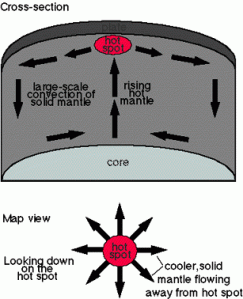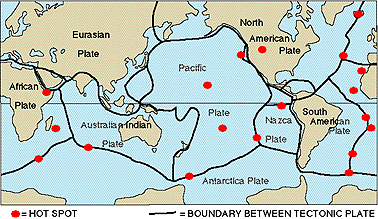Several folks have written in after seeing the news reports of lava in Hawaii flowing through the Royal Gardens Subdivision past the house of Jack Thompson, the only remaining resident… (The flow is approximately 500 yards away from his home…I haven’t decided if he’s awesome or insane, perhaps both)
For those that haven’t seen the footage yet, here it is…
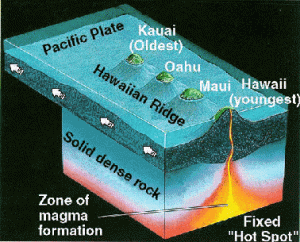
Hot Spot Diagram From Eruptions of Hawaiian Volcanoes: Past, Present, and Future: U.S. Geological Survey General Interest Publication.
Hawaiian volcanism is caused by what is known as a ‘hot spot.’ (an awesome understatement…) The hot spot is stationary, but the whole Pacific plate is in motion. The older islands were once located above the stationary hot spot but were carried away as the Pacific Plate drifted to the northwest. the Pacific Plate has been moving to the northwest an average of 3-3.5 inches (8-9 cm) per year.
About 95% of the world’s volcanoes are located near the boundaries of tectonic plates. The other 5% are thought to be associated with mantle plumes and hot spots. Mantle plumes are areas where heat and/or rocks in the mantle are rising towards the surface. A hot spot is the surface expression of the mantle plume.
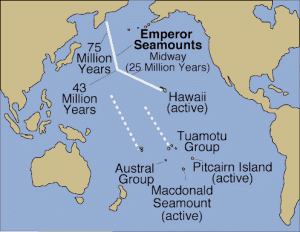 Here’s some background… In the 1960’s, Tuzo Wilson, one of the founders of the theory of plate tectonics, noticed some interesting features about ocean islands. On a map of the Pacific basin, he found three linear chains of volcanoes and submarine volcanoes (seamounts). Although separated by thousands of miles, the three linear chains are parallel to each other. Of the three, the Hawaii-Emperor seamount chain was the most well known.
Here’s some background… In the 1960’s, Tuzo Wilson, one of the founders of the theory of plate tectonics, noticed some interesting features about ocean islands. On a map of the Pacific basin, he found three linear chains of volcanoes and submarine volcanoes (seamounts). Although separated by thousands of miles, the three linear chains are parallel to each other. Of the three, the Hawaii-Emperor seamount chain was the most well known.
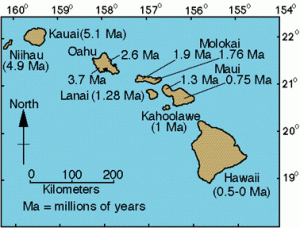
Wilson reviewed the reports that had been published on these island chains and recorded the age of each island. An interesting pattern emerged. For each chain, the islands become progressively younger to the southeast. The extreme southeast end of each chain is marked by active volcanoes.
At first glance the shape and topography of the Hawaii-Emperor volcanic chain might remind you of an island arc. However, volcanoes of the Hawaii-Emperor volcanic chain are progressively younger towards Hawaii and made of basalt. Island arcs are produced at convergent plate boundaries where an ocean plate is subducted beneath an adjacent ocean plate. The Aleutians of Alaska is an example. There is no age progression and andesite is the most common rock.
Before I continue, here’s some great YouTube video of Kilauea’s lava from December 9th 2011 It’s long, but notice how it piles up!!
Anyway, by the early 1970s, the plate tectonic theory and the presence of hot spots was generally accepted. In 1971, W. Jason Morgan suggested a more important role for hot spots. He proposed that hot spots result from hot, narrow plumes of material that rise from deep within the mantle.
As the hot mantle plume reaches the base of the lithosphere, it spreads laterally. The laterally spreading of the hot mantle helped to move the Earth’s rigid outer plates.
In all, Morgan proposed 20 different hot spots, some located along mid-ocean ridges and others, like Hawaii and Yellowstone, located within plates.
The lava that has been erupting from Kilauea made it all the way to the ocean on December 9th, 2011. Here’s some footage!
There is much much more information about the evolution of Hawaii’s volcanoes, their features, flow rates, life cycles, etc on Volcano World!
Thanks to Volcano Discovery Hawaii, EQ Reporter, the USGS, and Steve Mattox for some of the content within this post!

